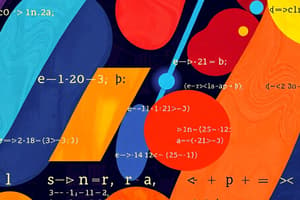Podcast
Questions and Answers
If a class MyCollection is designed to function with a for loop, but not necessarily hold all its data in memory at once, what interface should MyCollection implement?
If a class MyCollection is designed to function with a for loop, but not necessarily hold all its data in memory at once, what interface should MyCollection implement?
- `Iterable` only (correct)
- `Iterator` only
- Both `Iterable` and `Iterator`
- Neither `Iterable` nor `Iterator`
Consider a scenario where you need to process a very large file, line by line, but memory is a constraint. Which approach would be most efficient in terms of memory usage?
Consider a scenario where you need to process a very large file, line by line, but memory is a constraint. Which approach would be most efficient in terms of memory usage?
- Read the entire file into a string and split it into lines.
- Read the entire file into a list of strings and then iterate over the list.
- Use the `iter()` and `next()` functions to manually iterate through the file contents.
- Use a generator function with `yield` to produce each line as needed. (correct)
Suppose you have a custom class Countdown that yields numbers in descending order from a starting value down to 1. What should happen within the __iter__ method of the Countdown class?
Suppose you have a custom class Countdown that yields numbers in descending order from a starting value down to 1. What should happen within the __iter__ method of the Countdown class?
- Return a new instance of the `Countdown` class.
- Return the starting value of the countdown.
- Return `self` if the class is an iterator. (correct)
- Return the `next()` method.
Given an iterable object my_list, what is the primary difference between directly iterating over my_list in a for loop and creating an iterator using iter(my_list) and calling next()?
Given an iterable object my_list, what is the primary difference between directly iterating over my_list in a for loop and creating an iterator using iter(my_list) and calling next()?
If you have a list named data, and you want to create an iterator from it, but only want to retrieve elements that satisfy a specific condition. Which of the following is the most efficient way?
If you have a list named data, and you want to create an iterator from it, but only want to retrieve elements that satisfy a specific condition. Which of the following is the most efficient way?
What is the significance of raising a StopIteration exception in a custom iterator?
What is the significance of raising a StopIteration exception in a custom iterator?
Consider you are developing a data processing pipeline where data is read from a sensor, processed, and then logged. Each step is a generator function. What is the advantage of using generators in this pipeline?
Consider you are developing a data processing pipeline where data is read from a sensor, processed, and then logged. Each step is a generator function. What is the advantage of using generators in this pipeline?
Suppose you have a very large dataset that cannot fit into memory. You need to perform several operations on this dataset, such as filtering, mapping, and aggregation. How can you efficiently perform these operations using iterators and generators?
Suppose you have a very large dataset that cannot fit into memory. You need to perform several operations on this dataset, such as filtering, mapping, and aggregation. How can you efficiently perform these operations using iterators and generators?
In the context of iterators, what does "lazy evaluation" refer to?
In the context of iterators, what does "lazy evaluation" refer to?
Which of the following data structures inherently supports both the Iterable and Iterator interfaces without requiring any additional functions or methods?
Which of the following data structures inherently supports both the Iterable and Iterator interfaces without requiring any additional functions or methods?
How does the use of an Iterator contribute to memory efficiency when processing large datasets?
How does the use of an Iterator contribute to memory efficiency when processing large datasets?
You have two options for processing a large log file: loading the entire file into a list of strings or using an iterator to process it line by line. What is a significant advantage of using the iterator approach?
You have two options for processing a large log file: loading the entire file into a list of strings or using an iterator to process it line by line. What is a significant advantage of using the iterator approach?
Suppose you want to create a custom iterator that generates an infinite sequence of prime numbers. What is the most appropriate way to indicate that the iterator should continue indefinitely?
Suppose you want to create a custom iterator that generates an infinite sequence of prime numbers. What is the most appropriate way to indicate that the iterator should continue indefinitely?
Consider a scenario where you are working with a generator that yields potentially large objects. To ensure efficient memory management, what should you do after consuming each object?
Consider a scenario where you are working with a generator that yields potentially large objects. To ensure efficient memory management, what should you do after consuming each object?
What is the relationship between Iterable and Iterator in Python?
What is the relationship between Iterable and Iterator in Python?
Why are list, dict, and str considered Iterable but not Iterator objects in Python?
Why are list, dict, and str considered Iterable but not Iterator objects in Python?
If you have an extremely large dataset that is being processed using an iterator, and midway through the processing, you need to restart the iteration from the beginning, what would be the most appropriate approach?
If you have an extremely large dataset that is being processed using an iterator, and midway through the processing, you need to restart the iteration from the beginning, what would be the most appropriate approach?
When would you choose to implement a custom iterator in Python?
When would you choose to implement a custom iterator in Python?
Which of the following is a key characteristic that distinguishes an Iterator from a regular Iterable?
Which of the following is a key characteristic that distinguishes an Iterator from a regular Iterable?
Flashcards
Iterable
Iterable
An object capable of returning its members one at a time. Examples include lists, tuples, and strings.
Iterator
Iterator
An object that produces the next value in a sequence when next() is called on it. It raises StopIteration when no more values are available.
iter() function
iter() function
Converts an iterable (e.g., list, string) into an iterator.
isinstance()
isinstance()
Signup and view all the flashcards
next() function
next() function
Signup and view all the flashcards
StopIteration
StopIteration
Signup and view all the flashcards
Iterable vs. Iterator
Iterable vs. Iterator
Signup and view all the flashcards
How for loops Work
How for loops Work
Signup and view all the flashcards
Study Notes
Iterators
- Data types that can be directly used in a
forloop include collections likelist,tuple,dict,set, andstr, as well as generators. - Objects that can be used in a
forloop are called Iterable. isinstance()can verify if an object is Iterable.
Iterator Usage
- Generators can be called by
next()repeatedly to return the next value until aStopIterationerror is raised. - An object that can be called by
next()is called an Iterator. isinstance()can check if an object is an Iterator.
Iterator Types
- Generators are Iterator objects.
list,dict, andstrare Iterable, but not Iterator.- Use
iter()to turnlist,dict, andstrinto Iterator.
Why List, Dict, Str are not Iterator
- Iterator objects represent a data stream.
- Iterator objects can be called by
next()to return the next data until aStopIterationerror. - The data stream, is an ordered sequence with an unknown length, which can be calculated on demand by
next(). - The calculation of Iterator is lazy, and it is calculated only when the next data is needed.
- Iterator can represent an infinite data stream, such as the set of natural numbers, while a
listcannot store all natural numbers.
Summary
- Objects that can be used in a
forloop are Iterable. - Objects that can be used by
next()are Iterator, which represent a lazy calculation sequence. - Collection data types like
list,dict, andstrare Iterable but not Iterator, but an Iterator object can be obtained through theiter()function.forloops in Python are implemented by calling thenext()function.
Studying That Suits You
Use AI to generate personalized quizzes and flashcards to suit your learning preferences.



